Citroen C4 PICASSO 2016 2.G Owner's Manual
Manufacturer: CITROEN, Model Year: 2016, Model line: C4 PICASSO, Model: Citroen C4 PICASSO 2016 2.GPages: 527, PDF Size: 13.72 MB
Page 221 of 527
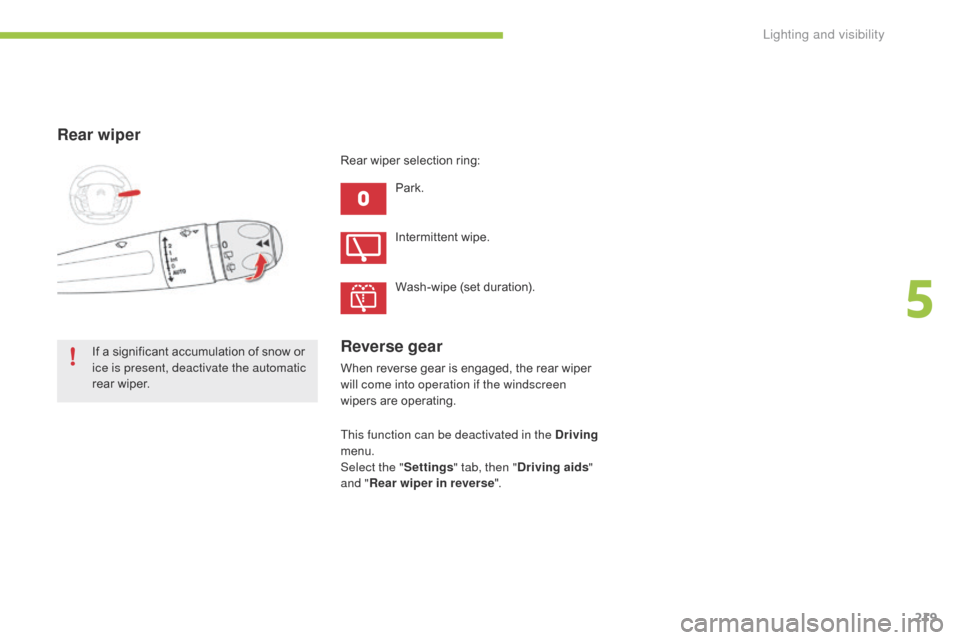
219
C4-Picasso-II_en_Chap05_eclairage-visibilite_ed01-2016
Rear wiper
Park.
If
a
significant
accumulation
of
snow
or
i
ce is present, deactivate the automatic
rear
wiper. Intermittent
wipe.
Wash-wipe
(set duration).
Rear
wiper selection ring:
Reverse gear
When reverse gear is engaged, the rear wiper w
ill come into operation if the windscreen
wipers
are operating.
This function can be deactivated in the Driving
menu.
Select the " Settings" tab, then " Driving aids"
and " Rear wiper in reverse ".
5
Lighting and visibility
Page 222 of 527
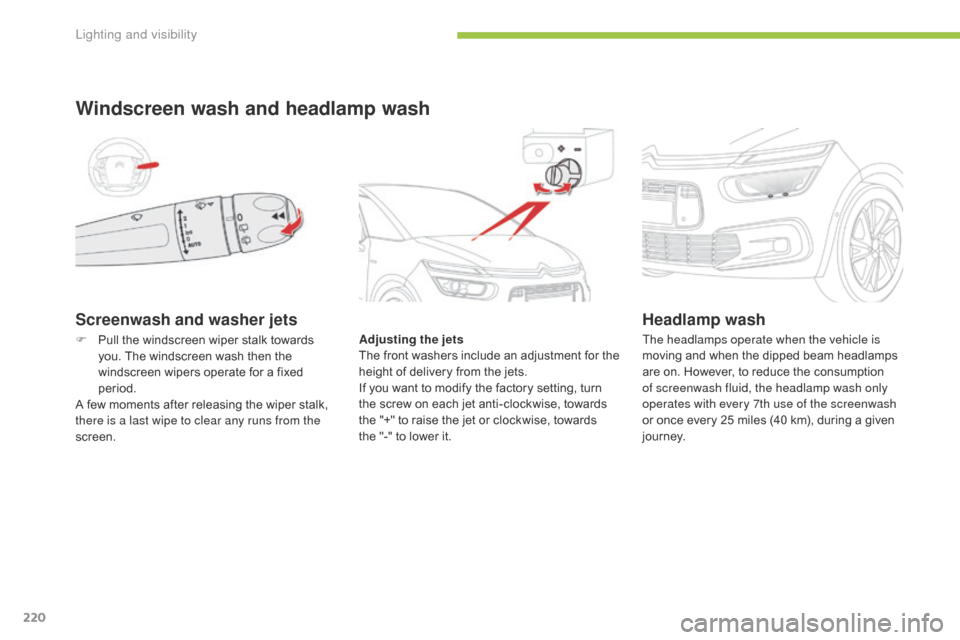
220
C4-Picasso-II_en_Chap05_eclairage-visibilite_ed01-2016
Screenwash and washer jets
Windscreen wash and headlamp wash
Adjusting the jets
The f ront w ashers i nclude a n a djustment f or t he
h
eight of delivery from the jets.
If
you want to modify the factory setting, turn
t
he screw on each jet anti-clockwise, towards
t
he "+" to raise the jet or clockwise, towards
t
he "-" to lower it.
Headlamp wash
F Pull the windscreen wiper stalk towards y
ou. The windscreen wash then the
w
indscreen wipers operate for a fixed
p
eriod.
A
few moments after releasing the wiper stalk,
t
here is a last wipe to clear any runs from the
screen. The headlamps operate when the vehicle is
moving
and when the dipped beam headlamps
a
re on. However, to reduce the consumption
o
f screenwash fluid, the headlamp wash only
operates with every 7th use of the screenwash
or
once every 25 miles (40 km), during a given
j
o u r n ey.
Lighting and visibility
Page 223 of 527
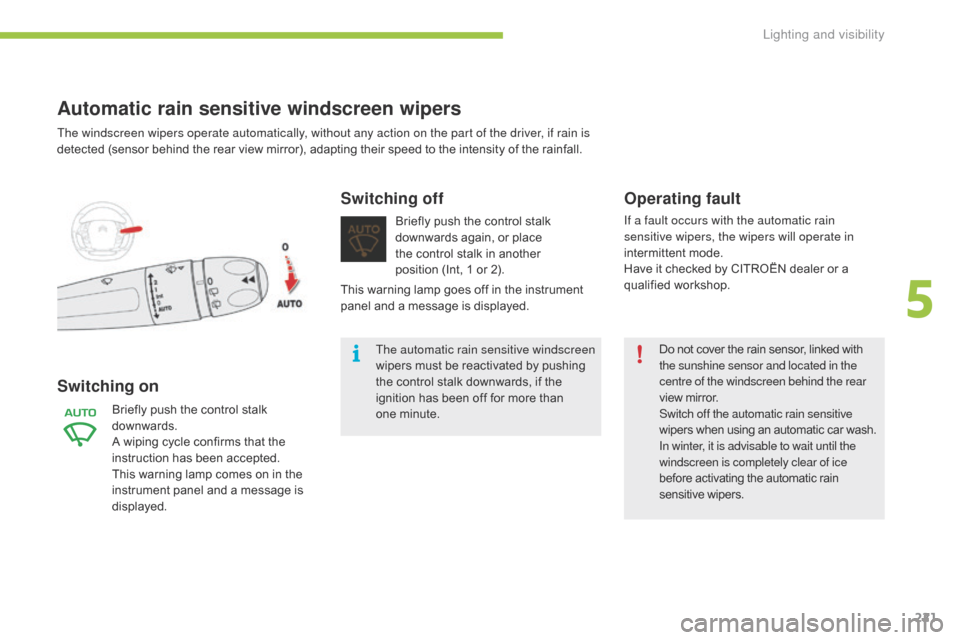
221
C4-Picasso-II_en_Chap05_eclairage-visibilite_ed01-2016
Do not cover the rain sensor, linked with the sunshine sensor and located in the
centre of the windscreen behind the rear
view
mirror.
Switch off the automatic rain sensitive
wipers
when using an automatic car wash.
In winter, it is advisable to wait until the
windscreen is completely clear of ice
before
activating the automatic rain
sen
sitive
w
ipers.
Operating fault
If a fault occurs with the automatic rain
sensitive wipers, the wipers will operate in
intermittent mode.
Have
it checked by CITROËN dealer or a
q
ualified
w
orkshop.
The windscreen wipers operate automatically, without any action on the part of the driver, if rain is
detected
(sensor
behind
the
rear
view
mirror),
adapting
their
speed
to
the
intensity
of
the
rainfall.
Switching on Switching off
The automatic rain sensitive windscreen
wipers
must be reactivated by pushing
t
he control stalk downwards, if the
i
gnition has been off for more than
o
ne minute.
Briefly
push
the
control
stalk
d
ownwards.
A
wiping
cycle
confirms
that
the
i
nstruction
has
been
accepted.
This
warning
lamp
comes
on
in
the
i
nstrument
panel
and
a
message
is
d
isplayed. Briefly
push the control stalk
d
ownwards again, or place
t
he control stalk in another
p
osition (Int, 1 or 2).
Automatic rain sensitive windscreen wipers
This warning lamp goes off in the instrument p
anel and a message is displayed.
5
Lighting and visibility
Page 224 of 527
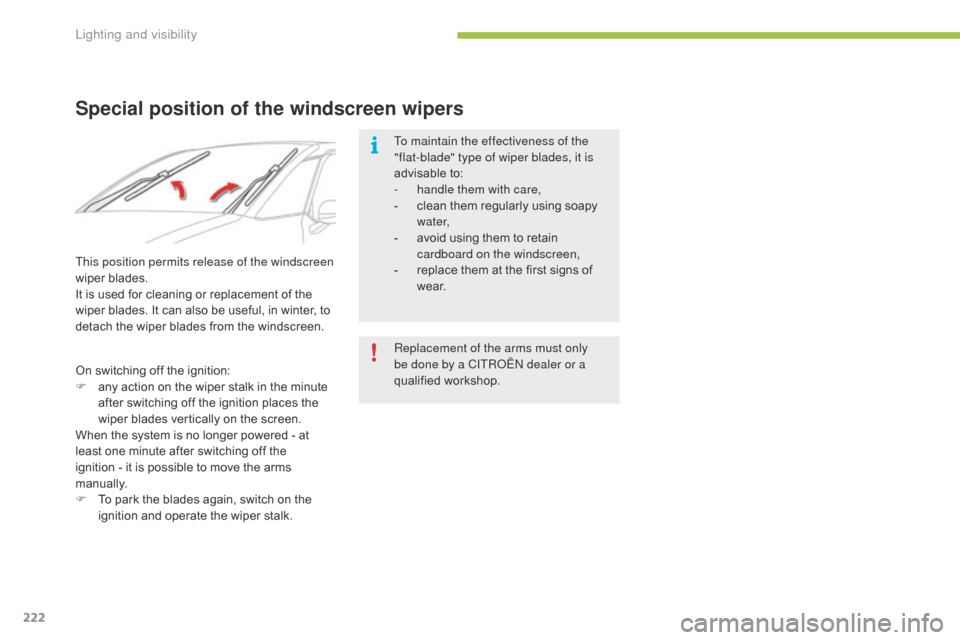
222
C4-Picasso-II_en_Chap05_eclairage-visibilite_ed01-2016
Special position of the windscreen wipers
To maintain the effectiveness of the
"flat-blade" type of wiper blades, it is
advisable
t
o:
-
h
andle them with care,
-
c
lean them regularly using soapy
w
ater,
-
a
void using them to retain
c
ardboard on the windscreen,
-
r
eplace them at the first signs of
w
e a r.
This position permits release of the windscreen
wiper
blades.
It
is
used
for
cleaning
or
replacement
of
the
w
iper
blades.
It
can
also
be
useful,
in
winter,
to
d
etach
the
wiper
blades
from
the
windscreen.
On
switching
off
the
ignition:
F
a
ny
action
on
the
wiper
stalk
in
the
minute
a
fter
switching
off
the
ignition
places
the
w
iper
blades
vertically
on
the
screen.
When
the
system
is
no
longer
powered
-
at
l
east
one
minute
after
switching
off
the
i
gnition -
it
is
possible
to
move
the
arms
m
anually.
F
T
o
park
the
blades
again,
switch
on
the
i
gnition
and
operate
the
wiper
stalk. Replacement of the arms must only
be done by a CITROËN dealer or a
qualified
w
orkshop.
Lighting and visibility
Page 225 of 527
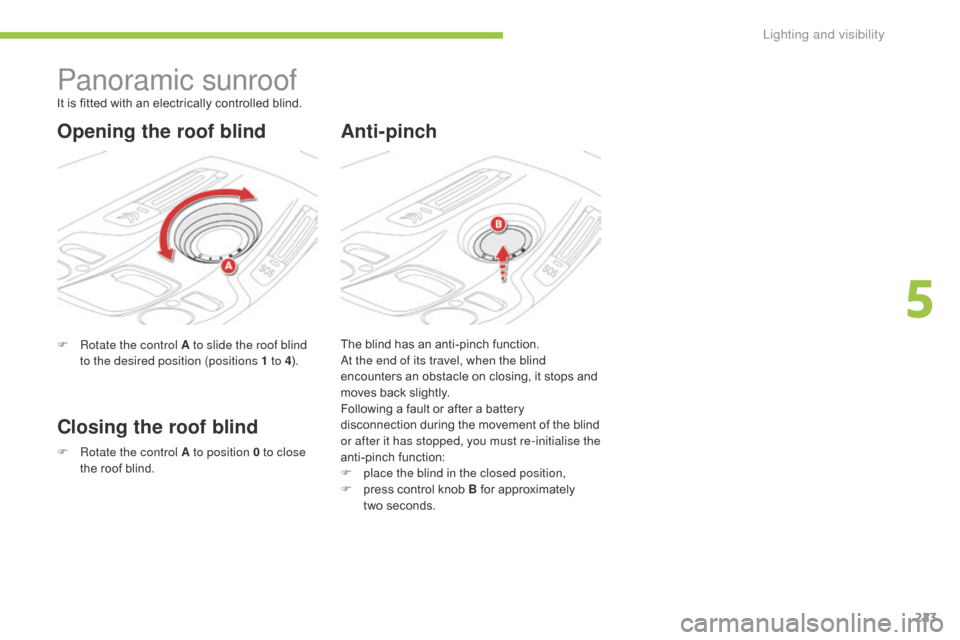
223
C4-Picasso-II_en_Chap05_eclairage-visibilite_ed01-2016
Panoramic sunroof
F Rotate the control A to slide the roof blind to the desired position (positions 1 to 4 ).
Closing the roof blindAnti-pinch
It is fitted with an electrically controlled blind.
Opening the roof blind
F Rotate the control A to position 0 to close
the roof blind. The
blind has an anti-pinch function.
At the end of its travel, when the blind
encounters an obstacle on closing, it stops and
m
oves back slightly.
Following a fault or after a battery
d
isconnection during the movement of the blind o
r after it has stopped, you must re-initialise the
anti-pinch f unction:
F
p
lace the blind in the closed position,
F
p
ress control knob B for approximately
t
wo seconds.
5
Lighting and visibility
Page 226 of 527
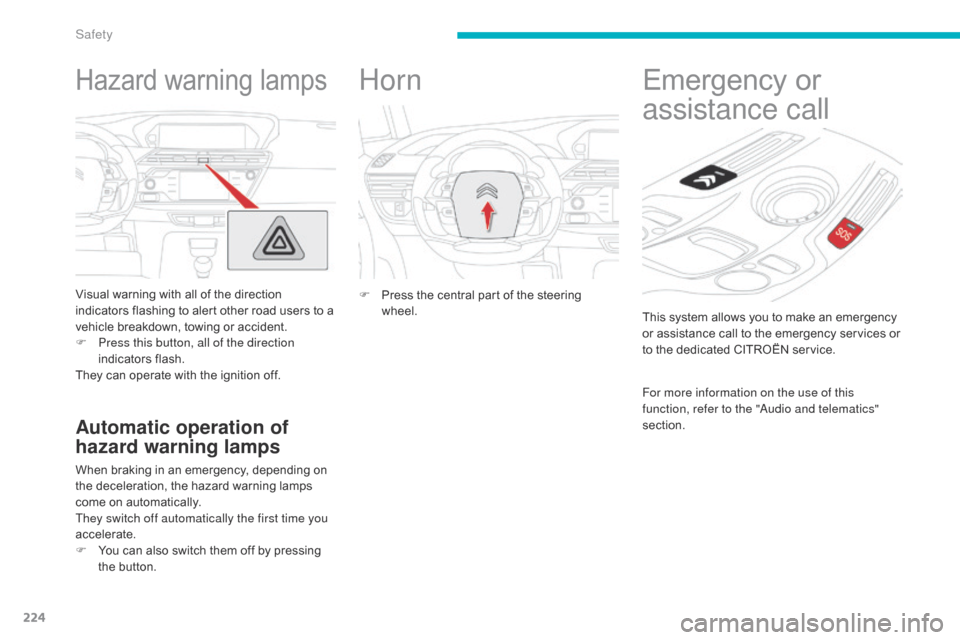
224
C4-Picasso-II_en_Chap06_securite_ed01-2016
Hazard warning lamps
Visual warning with all of the direction i
ndicators flashing to alert other road users to a
v
ehicle breakdown, towing or accident.
F
P
ress this button, all of the direction
indicators
f
lash.
They
can operate with the ignition off.
Automatic operation of
hazard warning lamps
When braking in an emergency, depending on the deceleration, the hazard warning lamps
c
ome on automatically.
They switch off automatically the first time you
accelerate.
F
Y
ou can also switch them off by pressing
t
he button.
Horn
F Press the central part of the steering w
heel. This
system allows you to make an emergency
o
r assistance call to the emergency services or
t
o the dedicated CITROËN service.
Emergency or
a
ssistance call
For more information on the use of this
function, refer to the "Audio and telematics"
section.
Safety
Page 227 of 527
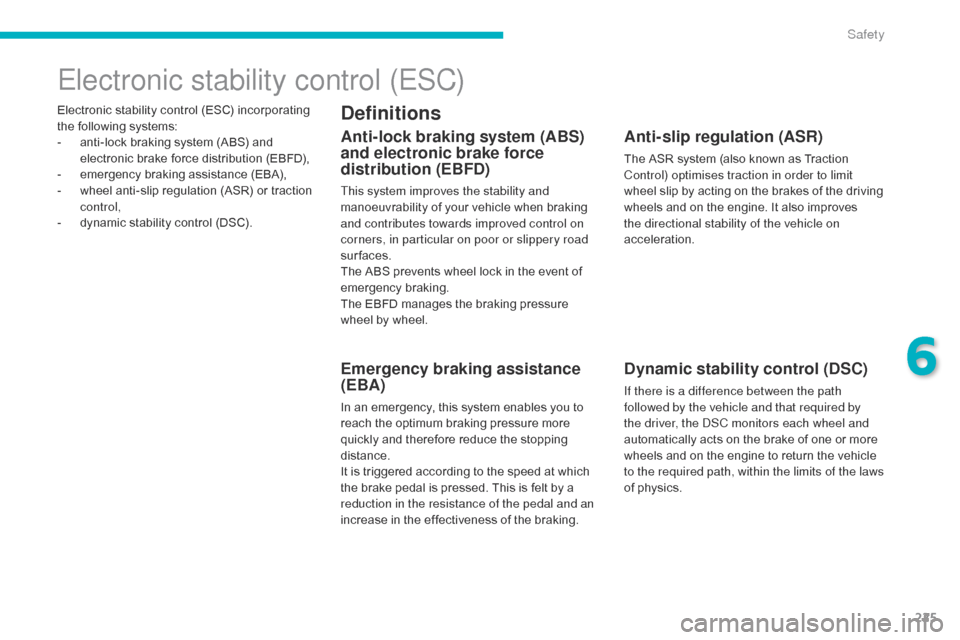
225
C4-Picasso-II_en_Chap06_securite_ed01-2016
Electronic stability control (ESC) incorporating the following systems:
-
a
nti-lock braking system (ABS) and
e
lectronic brake force distribution (EBFD),
-
e
mergency braking assistance (EBA),
-
w
heel anti-slip regulation (ASR) or traction
c
ontrol,
-
d
ynamic stability control (DSC).
Electronic stability control (ESC)
Definitions
Anti-lock braking system (ABS)
and electronic brake force
distribution (EBFD)
This system improves the stability and
manoeuvrability of your vehicle when braking
a
nd contributes towards improved control on
corners, in particular on poor or slippery road
surfaces.
The
ABS prevents wheel lock in the event of
em
ergency
b
raking.
The
EBFD manages the braking pressure
w
heel by wheel.
Emergency braking assistance
(EBA)
In an emergency, this system enables you to reach the optimum braking pressure more
q
uickly and therefore reduce the stopping
di
stance.
It
is triggered according to the speed at which
t
he brake pedal is pressed. This is felt by a
r
eduction in the resistance of the pedal and an
increase
in the effectiveness of the braking.
Anti-slip regulation (ASR)
The ASR system (also known as Traction Control) optimises traction in order to limit
wheel
slip by acting on the brakes of the driving
w
heels and on the engine. It also improves
t
he directional stability of the vehicle on
acceleration.
Dynamic stability control (DSC)
If there is a difference between the path
followed by the vehicle and that required by
the driver, the DSC monitors each wheel and
automatically
acts on the brake of one or more
w
heels and on the engine to return the vehicle
t
o the required path, within the limits of the laws
of
physics.
6
Safety
Page 228 of 527
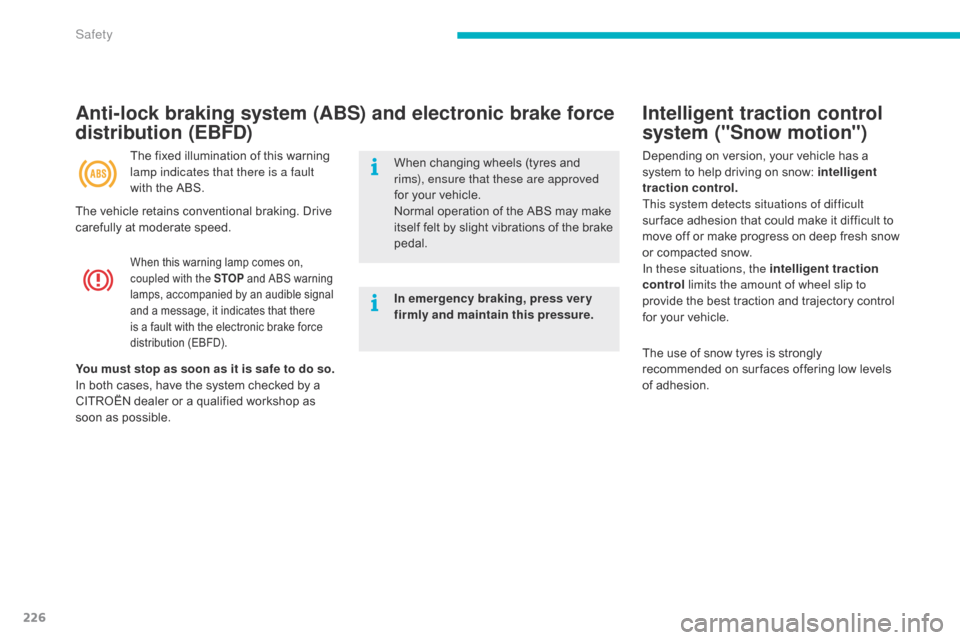
226
C4-Picasso-II_en_Chap06_securite_ed01-2016
Intelligent traction control
system ("Snow motion")
When this warning lamp comes on, coupled with the STOP and ABS warning
l
amps, accompanied by an audible signal
a
nd a message, it indicates that there
i
s a fault with the electronic brake force
di
stribution
(
EBFD).
Anti-lock braking system (ABS) and electronic brake force
distribution (EBFD)
The fixed illumination of this warning lamp indicates that there is a fault
with
the ABS. Depending
on version, your vehicle has a s
ystem to help driving on snow: intelligent
traction control.
This system detects situations of difficult
sur face
adhesion that could make it difficult to
m
ove off or make progress on deep fresh snow
o
r compacted snow.
In these situations, the intelligent traction
control limits the amount of wheel slip to
provide
the best traction and trajectory control
f
or your vehicle.
The
use of snow tyres is strongly
r
ecommended on sur faces offering low levels
o
f adhesion.
When
changing wheels (tyres and
r
ims), ensure that these are approved
for
your vehicle.
Normal
operation of the ABS may make
i
tself felt by slight vibrations of the brake
ped
al.
In emergency braking, press ver y
firmly and maintain this pressure.
You must stop as soon as it is safe to do so.
In
both
cases, have the system checked by a
C
ITROËN dealer or a qualified workshop as
s
oon
as
possible.
The
vehicle retains conventional braking. Drive
c
arefully
at moderate speed.
Safety
Page 229 of 527
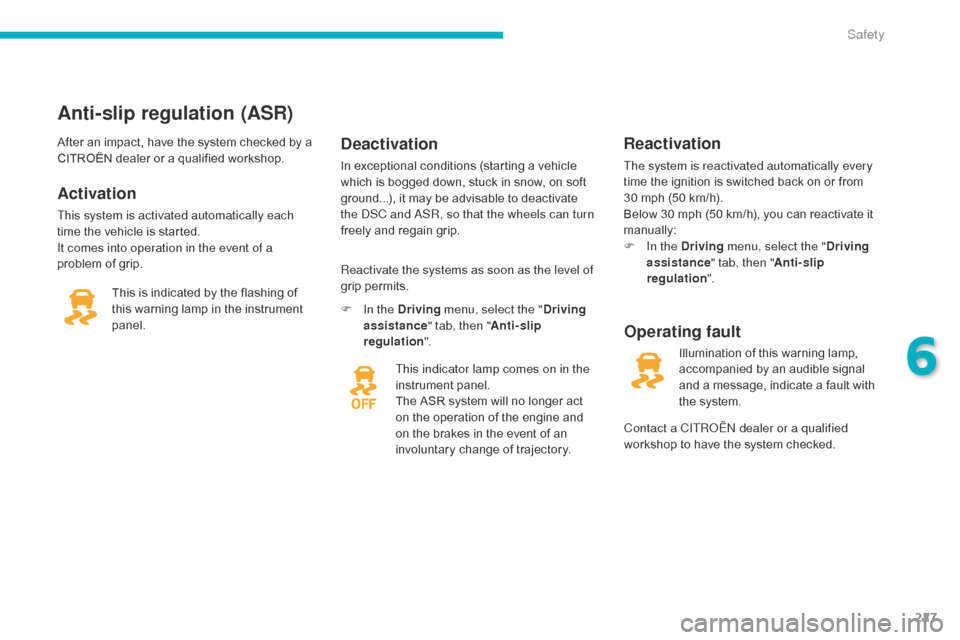
227
C4-Picasso-II_en_Chap06_securite_ed01-2016
Anti-slip regulation (ASR)
Activation
This system is activated automatically each
time the vehicle is started.
It comes into operation in the event of a
problem
of grip.
Deactivation
In exceptional conditions (starting a vehicle which is bogged down, stuck in snow, on soft
g
round...), it may be advisable to deactivate
t
he DSC and ASR, so that the wheels can turn
freely
and regain grip.
This
is
indicated
by
the
flashing
of
t
his
warning
lamp
in
the
instrument
pan
el. Reactivate the systems as soon as the level of
grip
permits.
F
I
n the Driving menu, select the " Driving
assistance " tab, then "Anti-slip
regulation ".
This indicator lamp comes on in the
instrument
pan
el.
The
ASR system will no longer act
o
n the operation of the engine and
o
n the brakes in the event of an
i
nvoluntary change of trajectory.
After
an
impact,
have
the
system
checked
by
a
C
ITROËN
dealer
or
a
qualified
workshop.
Operating fault
Reactivation
The system is reactivated automatically every
time
the ignition is switched back on or from
3
0 mph (50 km/h).
Below
30 mph (50 km/h), you can reactivate it
m
anually:
F
I
n the Driving menu, select the " Driving
assistance " tab, then "Anti-slip
regulation ".
Illumination
of this warning lamp,
a
ccompanied by an audible signal
a
nd a message, indicate a fault with
t
he system.
Contact a CITROËN dealer or a qualified
workshop
to have the system checked.
6
Safety
Page 230 of 527
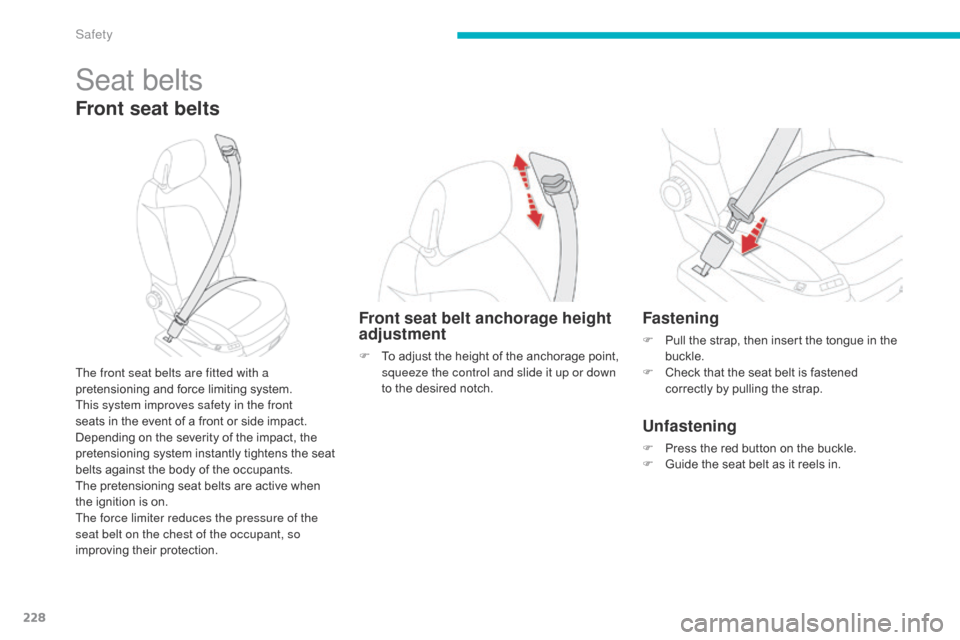
228
C4-Picasso-II_en_Chap06_securite_ed01-2016
Seat belts
Front seat belts
The front seat belts are fitted with a
pretensioning and force limiting system.
This system improves safety in the front
seats
in the event of a front or side impact.
D
epending on the severity of the impact, the
p
retensioning system instantly tightens the seat
b
elts against the body of the occupants.
The
pretensioning seat belts are active when
t
he ignition is on.
The force limiter reduces the pressure of the
seat belt on the chest of the occupant, so
improving
their protection.
Front seat belt anchorage height
adjustment
F To adjust the height of the anchorage point, s
queeze the control and slide it up or down
to
the desired notch.
Fastening
F Pull the strap, then insert the tongue in the buc
kle.
F
C
heck that the seat belt is fastened
c
orrectly by pulling the strap.
Unfastening
F Press the red button on the buckle.
F G uide the seat belt as it reels in.
Safety